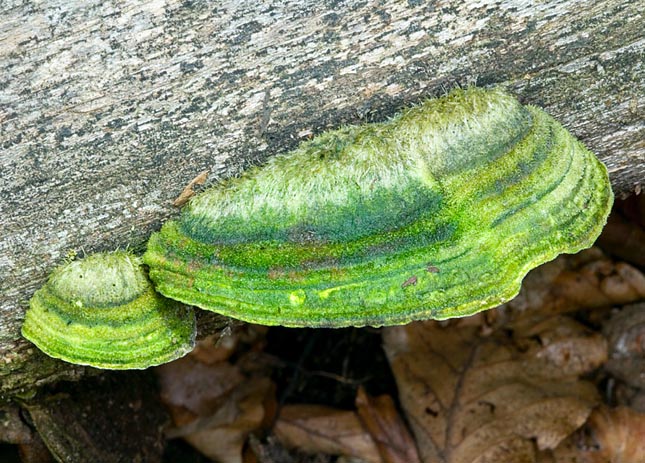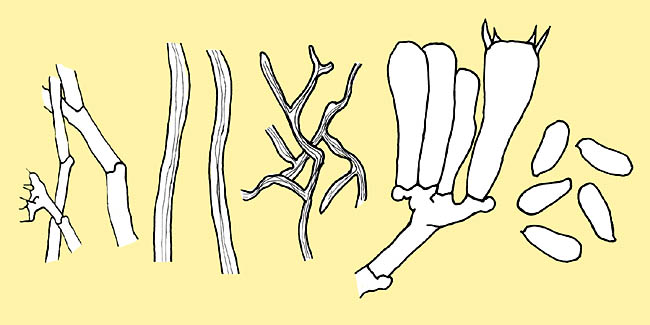
Text © Massimiliano Berretta

English translation by Mario Beltramini

Trametes gibbosa is often covered by algae conferring a greenish colouration © Giuseppe Mazza
Family: Polyporaceae Corda, 1839.
Genus: Trametes Fries, 1835.
Trametes gibbosa (Persoon) Fries, 1838.
The name comes from the Latin “gibba” which means “hump”, due to the appearance of the cap.
There are no common names in Italy and in Spain: on the contrary, in France it is known as “Tramète bossue”; in Germany as “Buckel-Tramete”, in UK as “Lumpy Bracket”, in USA as “Euro Beech Polypore”.
Description of the genus
To this genus belong often annual basidiomata, bracketed, single, imbricate or united in rosette, their pileus surface is often zoned and tomentose, the porous surface is whitish or grey, white context, sometimes greyish tubules; trimitic hyphal system with fibulate and hyaline generative hyphae, cylindrical-ellipsoidal, inamyloid; rarely growing on conifers and are agents of the white rot. The species typus is Trametes suaveolens (Linnaeus) Fries 1838.
Description of the species
Cap: annual basidiomata, bracketed, semicircular, imbricate, and measuring from 5 to 20 cm of length, per 1-4 cm of thickness; pileus surface grooved, zoned, villous, tuberculate, later becoming glabrous; of ochraceous-cream colour, green due to algal presence; obtuse and rounded edge.
Hymenium: white-cream pores, with elongated pores, often sinuous, 1 to 5 mm long and up to 1 mm broad; the tubules are whitish, mono or pluri-stratified.
Stem: absent.
Flesh: the context is thicker close to the substratum, up to 3 cm, coriaceous and fibrous, azoned, of white-cream colour.

Generative, skeletal and connective hyphae, basidium with basidioles and spores © Massimiliano Berretta
Habitat: annual species; it grows all year round on trunks and on dead stumps of broad-leaved trees, especially of beech.
Edibility: of no value.
Microscopy: trimitic hyphal structure with hyaline, fibulate and ramified generative hyphae, the connective hyphae have many ramifications, very numerous are also the skeletal hyphae, without septa; cystidia and cystidioles are absent; basidia are tetrasporic cylindrical or cylindrical-clavate, hyaline, with basal clamp connections, 15-20 × 4-6 µm; slender sterigmata; the basidiospores are hyaline, smooth, cylindrical or oblong and bent, inamylod, 4-5 × 1,8-2,3 µm.
Remarks. Annual species, common and diffused in Europe, amply distributed in Italy. It develops from autumn to spring, is normally destroyed by the insects and the parasites to which this species is much appreciated, for this reason it is difficult to conserve its exsiccata. It is very often covered by abundant algae which grant it a greenish colouration. One curiosity: they have found some enormous basidiomata, of even around one metre of breadth.
Similar species are: Trametes hirsuta (Wulfen) Lloyd 1924, which however has roundsh and smaller pores, thin context, pileus surface much velvety to the touch and more elongated spores; Trametes suaveolens (Linnaeus) Fries 1838, which may be similar as colouration but having, however, great and rounded pores, and the flesh emitting a good smell of anise, clearly bigger spores; Lenzites betulina (Linnaeus) Fries 1838 and Lenzites warnieri Durieu & Montagne 1860, similar as pileus appearance but with greyer or brown-ochraceous colours, and having, furthermore, gilled hymenium.
Synonyms: Merulius gibbosus Persoon, 1795 (basionym); Daedalea gibbosa (Persoon) Persoon, 1801; Lenzites gibbosa (Persoon) Hemmi, 1939; Polyporus gibbosus (Persoon) P. Kummer, 1871; Pseudotrametes gibbosa (Persoon) Bondartsev & Singer, 1944.
→ For general notions about Fungi please click here.
→ To appreciate the biodiversity of MUSHROOMS please click here.
